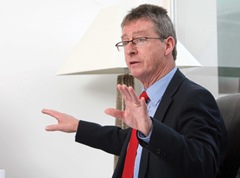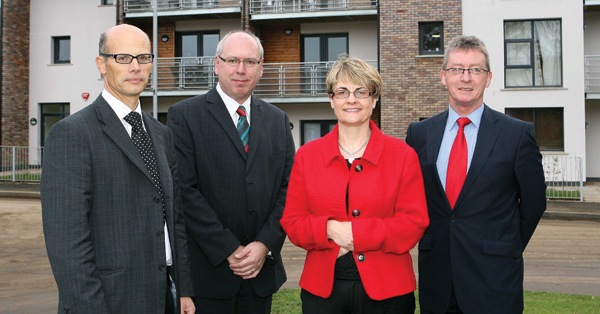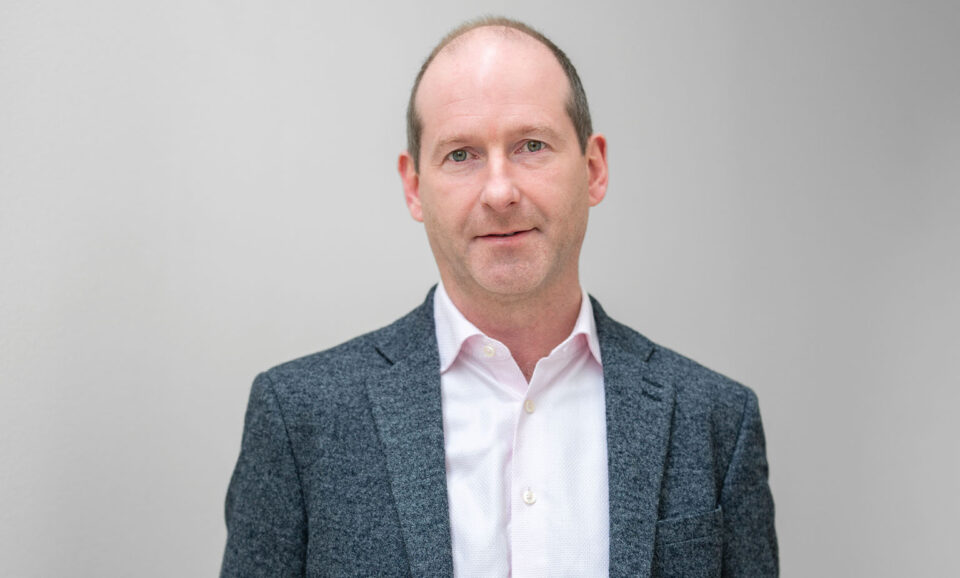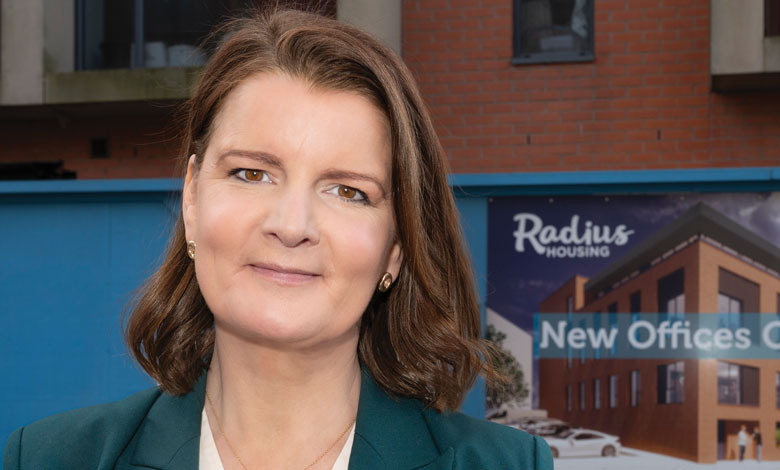Charting housing’s future
2nd November 2009Living together?
8th March 2010Living sustainably
What does sustainable living really mean? agendaNi brought together four main players in housing and sustainability to discuss the subject at Woodbrook, Northern Ireland’s first eco-village on the outskirts of Lisburn.
Sustainability has been on the agenda for almost 20 years but we are only now seeing environmentally friendly homes being built on a large scale. Why has it taken so long to put the policy into practice?
Jim Kitchen:
I think with every big new idea, it does take a long time to become embedded in consciousness. I think if we look back a decade and examine where the public understanding of climate change was at that stage and compare that to what it is today, I think sustainability and an awareness of sustainability falls into much the same category.
In terms specifically of housing, ultimately it’s only regulation that will allow the mass market to move and it’s only building regulations that will make sure that every new house is built to the same standard as the most advanced houses are now.
I think it’s an inevitable agenda and there are pioneers, there are first movers. And we’re sitting in a development today that reflects that sort of thinking but the whole of the market will move much more slowly.
Margaret Ritchie:
My first priority is to address social housing need throughout Northern Ireland so therefore I have to ensure that I’m putting roofs over people’s heads and tackling the very long waiting list, which is a difficulty at the moment in terms of the scarce resources.
So, in that context, it is difficult to push this agenda on. But notwithstanding the issue of scarce resources, the New Housing Agenda which I announced in February 2008 gives a high priority to the provision of more energy efficient housing and from April of 2008, all new social housing has to be built to Code 3 of the Code for Sustainable Homes, in effect making them 25 per cent more energy efficient.
This debate is also about tackling fuel poverty because fuel poverty is still a prime issue.
In parallel with all of this, there are other organisations who are building houses out in Holywood that I visited last year. So I welcome that, it is highly desirable, but juxtaposed against that is the whole area of scarce resources and my first priority is to provide houses for those who are in need.
Patrick Clarke:
It’s got to come through building regulations so the whole market has to respond to a minimum standard. But equally it’s clear that the public sector and social housing is able to take a lead because it’s got the resources, and the ability to encourage the social housing providers to meet particular standards.
In terms of the time frame for moving forward from ‘This Common Inheritance’1 to where we are now, there is an interesting contrast between the UK and Ireland and other parts of Europe.
In parts of Holland and Germany and Scandinavia, public authorities such as city development companies play a much more pro-active role in actually delivering development whereas in this country we’ve left the responsibility for housing delivery much more to the private sector. And therefore in order to get what we want, whether it’s social-community infrastructure, utility infrastructure and roads, social housing or high levels of energy efficiency, all of those things have got to be clawed back ultimately from the land value.
Margaret Ritchie:
And we believe in direct intervention. The other area is the whole area of developer contributions. And I know that Chris has gone down the road of voluntary contributions because of lack of movement on the part of government. But for my part, I want to see it on the statute book, notwithstanding the economic downturn at the moment.
Patrick Clarke:
The majority of developers that I have come across are seeking to provide housing at a competitive price, respond to what they perceive to be a market, and are very risk-averse and conservative in the way they operate. And frankly if they don’t think residents are putting it at the top of their agenda and are going to pay a premium, they won’t go near it.
I think why this development is so pioneering is because it’s taken that risk, actually put the eco-aspiration and vision at the forefront and made that a selling point and a distinctive characteristic of the scheme, and going well beyond the minimum standards that are required under regulation and beyond the standard that most house-buyers would expect, to set a new benchmark.
Margaret Ritchie:
And probably at long last, we’re trying to fulfil the commitments of the Kyoto Protocol back some 11 years ago.
Christopher Carvill:
Public housing is certainly addressing it through Code 3 and the various measures the Minister has just set out. Private housing, as Patrick says, is in a position where it’s in a very competitive market and has to get a return on its money. So it becomes a major hurdle for developers in terms of the cost to achieve those energy improvements.
Sustainability in my mind is not just energy improvement. There’s a whole range of things from the number of people living in an area to how they interact between their various homes, how they interact with the road, the space outside their homes etc. And there is a dearth of understanding of how design can influence the sustainability of a development over a longer period.
It’s not understood by the developers in the main. It’s not understood by the planners. It’s not understood by the Roads Service, and all of them have policies that are contrary to actually creating a sustainable development.
What makes a sustainable community?
Patrick Clarke:
Fundamentally, the most important thing is that people want to live in a neighbourhood and in a place because if people don’t want to live there, it’s not sustainable.
From a strategic urban design perspective, we think some of the key ingredients are about communities having the critical mass of people to support good quality local facilities that they can walk to. So that introduces the concept of the ‘walkable neighbourhood’.
The idea is that people are able to meet most of their day-to-day needs within a comfortable walking distance of home and live in an environment that they identify with. In a lot of the social surveys that have been done on new housing estates, people feel dislocated from where they work and from their neighbours, and they haven’t engendered a sense of community.
There’s a sense that, potentially, developers have sought to sell houses in the same way as people sell cars or plasma televisions, just simply as products. The downside of that is that people have lost the sense of identity, lost the ability to meet their neighbour in the street or at the local shop, and so develop the relationships beyond the family.
Jim Kitchen:
We’ve spent a lot of time in the last couple of decades planning not for people but for cars. You can see that exemplified much more potently in the States where you have this idea of the ‘doughnut city’ where everybody lives in the suburbs and they work in the centre, but they move out to the ‘meat’ of the donut at night and the bit in the middle is left empty. And we don’t want to see us continuing down that path here.
It’s trying to make places well-connected. We were talking just before we started today about Freiburg. It’s a city in Germany and there, when they built this new suburb called Vauban, the very first thing they put in place was an extension to the tram system.
That’s not to say that people don’t have cars. Plenty of people do but they don’t need to use them for their daily needs because those things are locally available.
Christopher Carvill:
In my opinion, the economic is number one, social is number two and environmental is number three. You need the first two before you actually have sustainability. The environmental actually could be dropped off and you could still have a sustainable development. It’s better with it.
Margaret Ritchie:
I think it’s a balance of the three – of the environmental, the economic and the social. And naturally, coming from my perspective, better housing does lead to better communities and more sustainable housing can develop those more sustainable communities.
The whole area of a shared society, a more integrated society and a shared community is one of the first things that can help build sustainability from the social perspective. Because for too long, I think in Northern Ireland, particularly in urban areas, we’ve been living in deeply divided, segregated communities.
And it’s the one issue that we have perhaps been a bit dilatory about addressing. And maybe a bit scared and a bit afraid to do so because we think ‘that’s the elephant in the room’ and we’d rather not talk about it. If you have the environmental and the economic but if you don’t have the social, then you cannot develop that fair, prosperous society in which people can work together, in which they can live together.
What more can be done to improve shared housing in Northern Ireland?
Margaret Ritchie:
I have put a shared future at the very heart of the agenda and in terms of housing, we already have created some shared future housing estates in Enniskillen, Sion Mills, Banbridge, Lissize, in Rathfriland, and Loughbrickland. We also have shared future neighbourhoods, funded by the Housing Executive, through DSD and the International Fund for Ireland. The people who live in them want to get involved in shared activities, something of a common denominator they can work together on. Last year, I announced something like 12 of them and another tranche of about 12 again this year.
Some of them, they were difficult to allocate estates. But there was that compelling need within community to address dereliction and deprivation and flags and emblems. People are saying: “We don’t want to live in these estates, we want to address this problem.” That got people together, they found they had a common mission in life to address that and as a result many of the estates are now fully occupied, easier to allocate.
But I’m not discounting the fact that that doesn’t fully address the need for shared future housing and as a consequence I’m also looking at the common selection scheme. As you know that’s allocated on the basis of need, but we need to build a shared future into that. I’m coming to a belief that the existing allocation system can actually perpetuate division.
I’ve been holding meetings throughout Northern Ireland on how you build that shared future within housing. The time is now to do that, with the absence of violence, the institutions. We have segregation, we have to take down these euphemistic peace walls. I get the very distinct impression that people want to live together. They don’t want to live apart.
Christopher Carvill:
In terms of creating the environment that allows people to understand the problems of the other community: no violence, peace and the Assembly, they are the three basic ingredients for that.
Margaret Ritchie:
I don’t disagree. We have the conditions now – the absence of violence, we have political institutions. But we have people who are diametrically opposed politically who are locked together in government. It’s not saying that everything is perfect but we have a greater measure of stability. It’s about basic ways of doing that, it’s about people coming together, with people living together but there has to be that need within communities themselves.
Christopher Carvill:
Our experience would reflect what the Minister is saying. In our experience, the local communities, when you get in and talk to them, are pragmatic, sensible and reasonable to deal with. Where it goes astray is when politicians get involved in it. Especially if it’s coming up to election time – the drum comes out.
Margaret Ritchie:
I fully take on board that but I think it comes back to the issue of confidence. You can still have your identity and as long as you have a large degree of respect for the other person’s point of view, there’s nothing wrong with that, it doesn’t diminish you in any shape or way; in fact it can be very uplifting.
To me it’s not just about good relations because councils have good relations committees. Good relations simply perpetuate the situation because it’s ‘them and us’. It’s about integrating people.
Is there a design side to shared housing?
Patrick Clarke:
Housing is an underlying human need, to feel safe and comfortable and look for the best opportunities to bring up children and let them fulfil their aspirations – that’s fundamentally what most people are looking for. Clearly there is a difference between the need to address areas of conflict and tension where there is an unfortunate history. As we look to the future and recognise that towns and cities across Northern Ireland are going to grow substantially over the next 20 to 30 years, I think the same set of principles should be applied to the design of new communities.
There are issues over choosing the right places; will these places be perceived as neutral or are they associated with one side or the other and are we accommodating enough people to get that mix?
Margaret Ritchie:
Naturally I believe that the department is all about how you develop a normal society and that’s why I put the shared future at the centre of that. As you know we’re waiting on the publication of the cohesion, sharing and integration document and in fact I’ve tabled that myself because of the logjam at the centre.
In England, the Government is requiring all new homes to be carbon neutral by 2016. Should Northern Ireland adopt that standard or Is that too ambitious?
Christopher Carvill:
Yes, I think it’s too ambitious and I don’t think it will happen. I think the cost associated with it will prevent it. We priced a carbon neutral home; the actual over-cost of a 900 sq ft three bed semi-detached house was £60,000. We stopped pricing it at £60,000; there were extra costs on top. Even at that, we weren’t at the point where we could say: “This is a carbon neutral house”.
Jim Kitchen:
The building regulations, as they are moving forward, are designed to deal only with the carbon neutrality aspect of sustainability. Let me say, it is in the mind of DFP to follow what is happening in England. In 2010, they’re going to go to a further 25 per cent energy efficiency. In 2013, the plan is to go to 44 per cent more than today’s regulations and eventually carbon neutral by 2016.
Whether we’ll get there or not, I don’t know. There is going to be opposition from the industry saying: “We can’t do that”. Then there’s the tension with the regulator saying: “You have to do it”. Somewhere we’ve got to meet in the middle.
The one thing that changes the whole paradigm is the price of fuel. We’re sitting today at $79 a barrel, last week it was $75 a barrel. There are many observers who think that we’re going to be sitting at over $100 by 2012. If you are living in a very energy efficient home, you’re not going to have to spend £1,000 to fill your oil tank.
Patrick Clarke:
I do think in Northern Ireland there are particular issues related to social sustainability as well as economic sustainability that really need to be addressed in equal weight rather than locking onto a single environmental agenda. If you think about it in very simple terms, a street or road will have a life of 500 to 1,000 years, the buildings that line that road will have a life of 200 to 300 years but the technologies used for heating and so on are probably going to have a life of 25 years.
What we need to focus on is creating well-built, well-insulated homes that are adaptable and flexible so that as new technologies emerge, they are able to accommodate them in the same way as many of our best Victorian homes have seen the coming and going of coal, gas, electricity.
Margaret Ritchie:
There’s no doubt that it is highly desirable and you have to ask what do our citizens want? They want the most energy efficient houses and they want to be able to explore every possible method and they want to be able to tackle fuel poverty to stay warm in their houses, but there is a collision there on the issue of cost. We’re runn ing int o a ve ry difficult f i na nc i al situation whereby there’s going to be less money about as cuts could be over and above what is predicted. I think that’s where sometimes policies are, n ot nece ssaril y cross-cutting, ma ybe they operate in silos and that’s because of the issue of scarce resources.
From a departmental point of view, we have been trying to replace coal and Economy 7 with gas- and oil-enhanced installation and, at a fairly local level, the installation of solar panels and ventilation systems. I suppose those are i n the minority rather than the majority of cases.
Jim Kitchen:
We’re talking a lot today about new builds and the reality is houses built in the Victorian and Edwardian eras are still going to be around in 2050, in fact in the SDC we have calculated that some 75 per cent of homes standing today will still be around in 2050. So the challenge of building new premises needs also to be addressed in existing buildings and that’s the challenge of what we call retrofit – where there are affordability issues and what the payback times are going to be but equally in the social housing sector there is a very strong case for putting more emphasis on retrofit, rather than new builds, and bringing derelict housing back into circulation.
Margaret Ritchie:
That comes back to the whole Empty Homes Strategy. The whole idea would be to bring those houses back into the housing stock. Some are in the private sector, some are in the social sector used for decants or maintenance and some are at interfaces. I would love to see those houses back into use but it does take a little time.










